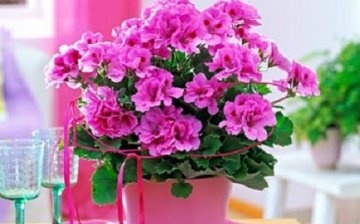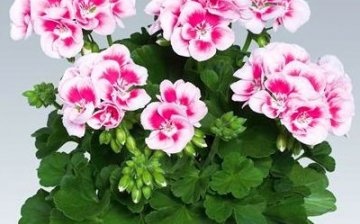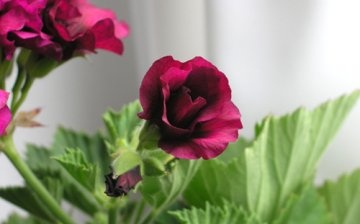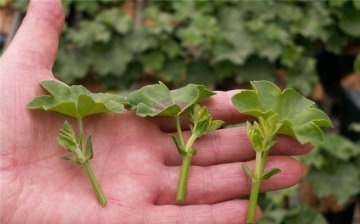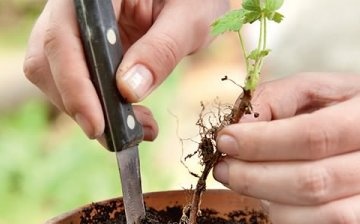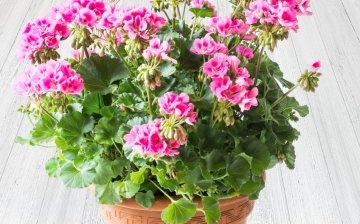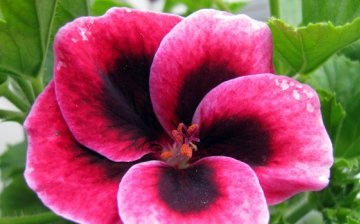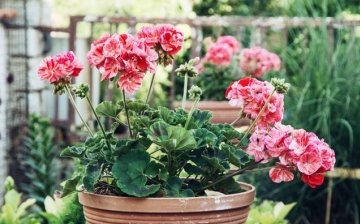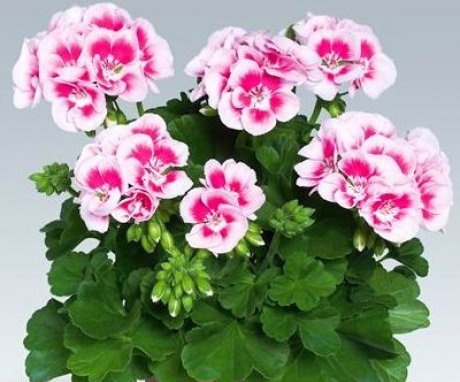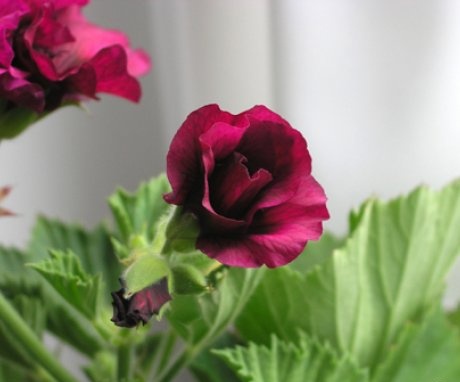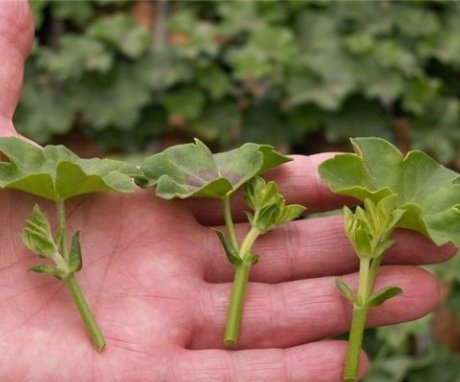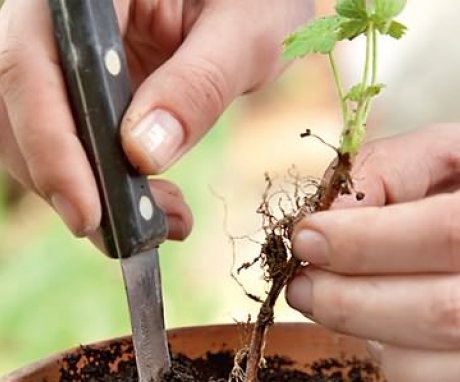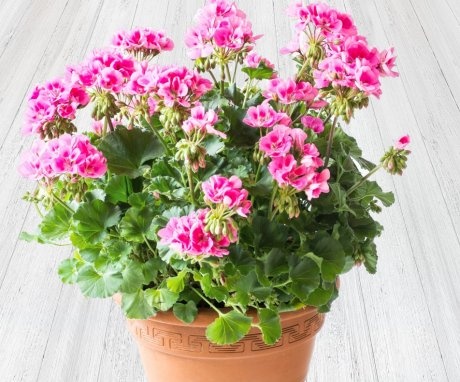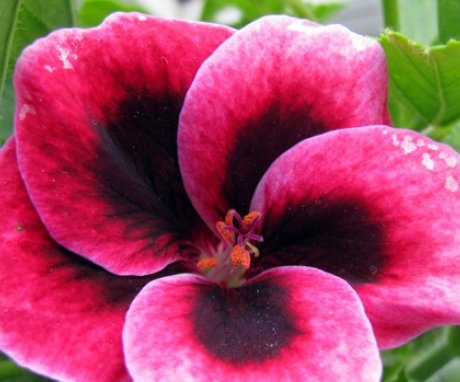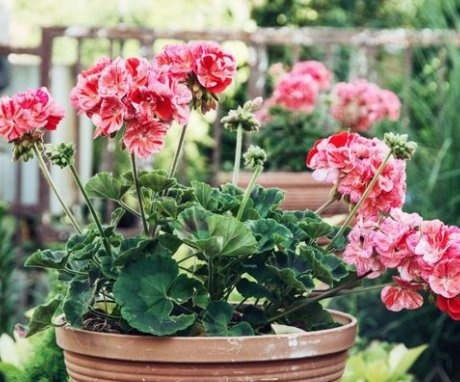The most beautiful types of room geranium
Geranium room has about 300 species. Homeland - South Africa. Indoor geranium unites all plants of the species grown at home. These include African geranium, called Pelargonium.
Content:
- Geranium room: description
- Types of room geranium
- Reproduction
- Landing
- Growing conditions
- Houseplant care
- Flower use
Geranium room: description
All room geraniums can be divided into two groups:
- Blooming with beautiful flowers.
- Fragrant, with inconspicuous flowers and fragrant leaves.
Geranium root is often branched, in some species it is pivotal. The stem can be erect or creeping (in ampelous plants). The leaves are dissected or in the form of a lobe, less often pinnate, covered with fine fine hairs. The colors can be monochromatic, zonal, colors - green of different intensities, with a grayish, red or blue tint. They all have long petioles.
Flowers are collected in cluster inflorescences, each of them consists of 5 or more rounded petals of red, pink, purple, white. In some varieties, they are marked with bright contrasting spots.
Geranium blooms almost all year round.
To do this, she needs to provide a sufficient amount of light and nutrients. Fruit-boxes are formed from the flowers. To many, they resemble the beak of a crane. The plant owes this similarity to several popular names that have taken root in different countries: "crane", "stork's nose". There are rather large seeds inside the fruit.
Types of room geranium
The most popular and beautiful types of room geranium:
- The most common is Zonal Geranium (edged, kalachik). It has 70 thousand varieties. The leaves are solid, with dark concentric circles of varying intensity. The stem is erect, if formed incorrectly, it grows up to 1 m in height. The flowers are bright, pink or white, simple in shape, semi-double or double.
- Ivy differs from the zonal shape of the stem. Long whips, decorated with smooth leaves, hang down. The flower is placed in hanging flowerpots.
- Royal grows to half a meter. Leaves are solid or with stripes, dark spots. The flowers are large, simple or double in shape, monochromatic, of various colors, with colored spots, veins, edges. Another name is English large-flowered.
- Fragrant geranium may have odors of lemon, pine needles, lemon balm, ginger, pineapple and other plants. Variety Strong-smelling has a rose aroma, Fragrant - apple. Some scents are not very pleasant. The flowers are inconspicuous, pink or purple. The bush needs to be pinched regularly so that it has a beautiful shape. It is used to make aromatic oils.
- Geranium Angel with flowers similar to viola... Ampelous bush, lashes are shorter than those of ivy, covered with inflorescences with a large number of flowers.
Unicum hybrids have strongly dissected, very fragrant leaves. The flowers are large and beautiful, but smaller than those of the Royal. Miniature and dwarf ones do not require pruning. Bloom profusely.
According to the shape of the flower, several groups of zonal geraniums can be distinguished:
- Rosaceae with flowers resembling roses.
- Cactaceous with cone-shaped petals.
- Stellate with pointed petals.
- A group of carnations with serrated petals stands out.
- Succulents are a special kind of geraniums. The stems of the plants are bizarrely curved. Some varieties have thorns.
Reproduction
Indoor geraniums are propagated:
- Seeds, but this method does not always guarantee the repetition of the maternal properties of the hybrids.
- Cuttings.
Seeds are sown in soil prepared from equal parts of peat, sand and a double portion of sod land. The main part of the soil mixture is placed in a bowl, at the bottom of which there is a drainage layer. Seeds are scattered over the surface at a distance of 2 cm from each other, then the remaining soil is covered with a thin layer. Moisten with a spray bottle.
Cover the dishes with glass or foil, set in a warm place (temperature about 20 ° C). Every day they ventilate by removing the glass and shaking off the drops from it. When the first seeds germinate, remove the shelter, lower the temperature (you can set it on the windowsill, where it is lower than in the rest of the room).
The next 2 months, the seedlings are watered, waiting until it has 2 real leaves. Plants are planted in separate pots of small diameter. To get a beautifully shaped plant, pinch the top after 6 leaves. When sowing seeds collected with their own hands, they are first scarified. To do this, you can grind them with sandpaper.
Propagate geranium cuttings it is possible almost all year round, but in spring the roots are formed on them more actively.
Take a stalk, keep it in the air for several hours in order to plant it. Planted in a bowl with loose earth or coarse sand. Do not hide. When the cutting is rooted, it can be transplanted into another pot.
Cuttings are often rooted in another way. The lower leaves are cut off, the cutting is placed in a glass of water and the roots are formed. Then they are planted in a pot.
Landing
The soil for growing room geraniums is not very fertile. Otherwise, the plant will have many leaves, but few flowers. The geranium pot should have enough holes to drain excess moisture. A layer of drainage is laid on the bottom of the dishes: expanded clay, pebbles, foam.
Water as the soil dries up. In winter in a cool room watering spend a couple of times a month. If the plant is in a warm room, moisturize more often. Plants that were planted in open ground are hidden in the house at the beginning of autumn. They do not tolerate transplanting well. Root system unable to hold a large amount of soil, so the roots are exposed.
To make the geranium easier to transfer, the branches are cut, limiting their height.
The cut off tops can be used for breeding. For the winter, a stem is left on which no more than 7 leaves grow. Shoots growing from leaf sinuses are removed. Leave those that grow from the root. Shoots are broken off after every 5 leaves. Do not prune geraniums in December and early January. Rejuvenating pruning is carried out, leaving 5 buds on the shoot.
Growing conditions
Geranium - unpretentious plant. But often she dies due to mistakes in care. Usually this:
- The temperature is too low. Optimal from 15 to 20 degrees. If it is below 10 ° C, the plant disappears.
- Excessive moisture and poor drainage in the pot. This is manifested by yellowing and wilting of the leaves. The root system rots and the plant dies.
- The lack of moisture is manifested by the fact that the leaves turn yellow and dry out at the edges.
- With insufficient light, the leaves grow small, with long petioles, some of them fall off. The plant stretches upward, has a pale appearance. It is better to install the flower on the southern windows. Cover from the sun only on particularly hot days.
- Geranium needs constant bush formation. In order for it to be branched, the shoots are pinched.If you do not plan to collect geranium seeds, the brushes are removed after flowering. This will improve the appearance of the plant and allow other buds to develop faster.
- The size of the pot matters. If the dishes are too wide, the plant will not bloom well.
- Geranium is transplanted when the roots of the plant begin to break through from the drainage holes. If not transplanted on time, the leaves will begin to turn yellow and fall off.
Houseplant care
Tips for caring for your hero:
- The main thing for caring for geraniums is not to flood it with water. It tolerates excess moisture much worse than drought. Room geranium leaves are not sprayed with water. Drops of moisture can remain between the villi, creating conditions for the development of fungal diseases.
- Geranium easily tolerates high temperatures.
- Sometimes, when there is insufficient lighting in the room, geraniums are illuminated with garden fluorescent lamps. This leads to active bud formation.
- Fertilizers are applied throughout the growing season. A good result is given by the use of liquid top dressing. Geranium reacts positively to iodine. A drop of iodine is dissolved in a liter of water. Mix thoroughly and water the plant. This must be done so that the solution does not get on the roots. Therefore, it is poured over the walls of the dishes. The plant after such feeding will actively bloom. You can use any mineral complex fertilizers with phosphorus. Organic is not added.
- The dried soil is periodically loosened to provide air access to the roots. Use an old fork or wooden stick for this.
- Geranium care includes pest control. Aphids and mites are destroyed by treating the lower part of the leaves with tobacco infusion with laundry soap. After a few hours, wash off with clean water. Fighting whitefly is more difficult. It is more expedient to immediately start using insecticides of the Confidor type.
- If brown spots form on geranium leaves, this is a sign of a fungal disease - rust. To combat it, they spray it with Fitosporin. High soil moisture causes damage to root rot, water droplets during irrigation - gray rot.
Flower use
Geranium used for landscaping an apartment. But in the spring, when the threat of return frosts has passed, it is better to plant it in a flower bed. All summer she will delight with lush flowering.
Geranium leaves are used in salads or for baking. Used as a condiment. This largely depends on the geranium variety and the personal preference of the owner. Geranium leaves are used to flavor clothes in wardrobes.
Application in medicine:
- Phytoncides secreted by leaves are capable of killing microorganisms that lead to various diseases. Therefore, an infusion of leaves and a decoction of roots are used to treat purulent wounds, diseases of the throat, gastrointestinal tract. Some types of geraniums have additional healing properties.
- The smell of geranium has a tonic and calming effect on the human nervous system. It helps relieve stress after a working day, improves sleep. Therefore, oils with various aromas are made from the leaves.
- Geranium is especially useful for patients with cardiovascular diseases. Its aroma improves the condition of patients with sinus arrhythmia, ischemic disease, normalizes blood circulation in the vessels.
More information can be found in the video:



